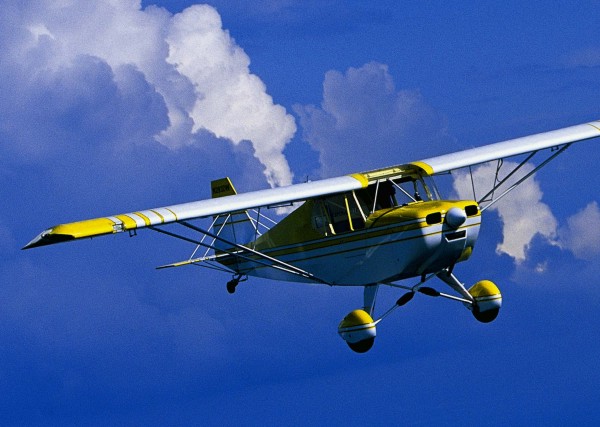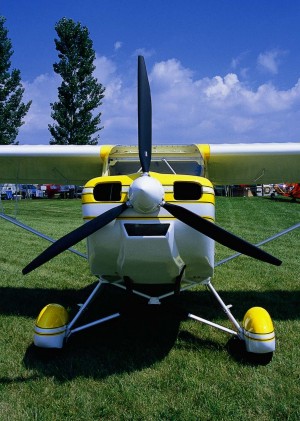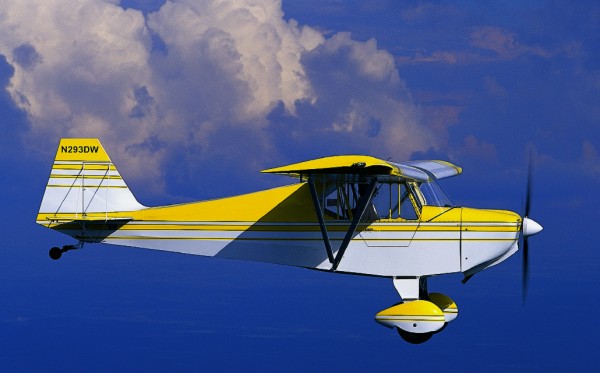

The Dakota Hawk’s airframe can accommodate engines from the four-cylin-der 65 and 85 hp and O-200 Continentals to the 80 and 100 hp Rotax 912 and 912S engines, as well as the six-cylinder Jabiru 3300, with the cowling modi-fied as needed to provide good airflow to the engine.

The all-wood high wing design offers reasonable visibility out the front and side windows. Optional wing tanks offer the opportunity to carry an additional 14 gallons of fuel, 7 on each side, to complement the 12-gallon header tank.

Dan Ward flies his beautifully finished Dakota Hawk, a product of a Fisher Flying Products kit. (See sidebar.) His aircraft was not the aircraft flown for this flight report, however it is a repre-sentative example. The airplane’s conventional bungee suspension landing gear system shows up nicely in this photo as well.

Dan’s yellow and white paint scheme helps the aircraft stand out in the sky no matter whether he’s flying in blue sky or cloudy conditions.
That makes his aircraft easily seen by other pilots from above, below, or alongside.

A Dakota Hawk will provide you a great ride through rainbow-filled skies!

Dan Ward’s Dakota Hawk
Realizing goals
Not all Light-Sport Aircraft will be composite.
Beautiful imported aircraft like the CT2K, Mirage, Jabiru, or Kolb Sport seem to best represent what many pilots imagine when they hear the words “light-sport aircraft.” These shapely composite designs are speedy and modern looking. Yet we’d be foolish to ignore the entire fleet of amateur-built light-sport aircraft (LSA) candidates. One of these is Fisher Flying Products’ Dakota Hawk.
Wood Still Works!
The Dakota Hawk is a simple, wood-structure light aircraft covered in fabric. Sound familiar? Sound comfortable and well understood? You bet it does.
While the Dakota Hawk may not be seen as a “modern” design, neither is it a vintage aircraft like Fisher’s fascinating Tiger Moth replica. Instead, most pilots probably link the Dakota Hawk to a golden era of general aviation when Piper Cubs, Taylorcrafts, and Luscombes were the darlings of light flight.
Regardless of what regulatory program it operates under, this high-wing taildragger is a sweet flier that will address what many pilots want out of aviation. North Dakota-based Fisher Flying Products (FFP) is owned and operated by Darlene Jackson-Hansen and husband Gene Hansen.
While the Dakota Hawk may be a middle-age-looking design, it has new features that reflect the state of the art in aviation design. One notable example is that our test Dakota Hawk abandoned the Continental or Lycoming engines common in golden-era airplanes for an 80-hp Rotax 912 engine. Once aloft a few hundred feet, the low rumble of the four-cylinder engine is quieter than many powerplants, making the plane a good neighbor in today’s noise-conscious world. The Dakota Hawk is approved for the 65 hp, 85-hp and O-200 Continental engines, as well as the 80and 100-hp Rotax 912 and 912S, and the six-cylinder Jabiru 3300.
Another relatively modern feature American pilots have embraced enthusiastically is folding wings. For trailering or hangar storage, the Dakota Hawk boasts a slick folding-wing design. The task needs only one person and takes just a few minutes and not only helps transport but also reduce your hangar costs if you rent space.
Like many of the potential LSA imports, Dakota Hawk’s instrument panel is big enough for most of the required gauges and radios you might want. But, unlike many LSA candidates, the aircraft has a simple bench-type seat. Though it may generate an image of the family sedan, it works well to add comfort, especially if the occupants are of different sizes. The seats are simple but serve the purpose without discomfort, though admittedly, we only flew for about an hour.
While most fiberglass airplanes use fiberglass or steel gear that flexes to absorb landing or taxi loads, Dakota Hawk employs a more conventional bungee suspension that can easily take up the bumps of a firm landing.
High Above EAA AirVentureOshkosh
My chance to fly the Dakota Hawk took place at EAA AirVenture Oshkosh with longtime Fisher dealer Mike Makepeace in the left seat. He offered me my choice of seats, but after a couple thousand hours giving instruction, I’m at home in the right seat. In fact, as a right-hander, I rather prefer it as the joystick is then in my right hand with my left available to work the throttle.
A shoulder belt system was installed, giving protection not afforded by mere lap belts. Most safety experts will tell you lap belts are insufficient in the event of any violent upset of the aircraft. If you install an emergency parachute, the manufacturer of that system will probably recommend shoulder belts or a four-point harness.
I can always find a few points about which to gripe, and the Dakota Hawk’s cockpit has its imperfections just like any aircraft. The throttle in our test aircraft had some forward creep necessitating a tight friction lock or a steady hand on the lever, which can be distracting or tiring or both. Also, brake pedals were only installed on the left side, so I never got a chance to experience them- though that was my fault for electing the right seat. However, with a thumb hook to engage detents, the flap handle was easily reached, and its position was easily observed in flight.
At the end of our flight, we put our headsets on the hat rack behind us. The space is useful for in-flight items, although heavier luggage shouldn’t end up in this spot.
Takeoff roll in the Dakota Hawk appeared to take longer than some ultralight pilots may prefer; however, temperatures were warm and the humidity was rather high during the Oshkosh air show. Additionally, the ultralight area at Oshkosh has a somewhat short, bumpy runway that is slightly uphill when launching to the northwest as we did. Conversely, Mike Makepeace said the model can leave pavement in about 350 feet.
The landing approach in the Dakota Hawk calls for significant power reduction as the plane slips through the air quite nicely at low speeds. I found I could use slips effectively, though you must stay alert to keep the nose down (it drifted upward on me as I tried to reduce landing speed).
During landing approaches, Mike emphasized the value of keeping the nose pointed at the ground until round-out, common advice for pilots flying any low-kinetic-energy aircraft. Commensurately, round-out felt a little sudden as the Dakota Hawk bled energy quickly, like most ultralights. It may not resemble the familiar appearance of most ultralights, but the aircraft can be operated like one for the most part. To put it in perspective, Fisher’s Dakota Hawk has a gross weight roughly equivalent to the empty weight of a Cessna 150.
Dakota-Sized Performance
Mike advised me to climb out under full power at about 55 mph. This speed with the Rotax engine producing full power yielded close to a 700 fpm rate of climb with two of us aboard; note we were more than 100 pounds under gross. At this weight and with the 80 hp working I expected even more climb from the Dakota Hawk. But to use the same earlier comparison, the Dakota Hawk climbs at more than double the pace of a typical 100-hp Cessna 150.
After we cleared the ultralight area pattern at EAA AirVenture, I ran the throttle up to its limit. The Dakota Hawk’s installed airspeed indicator (ASI) read 100 mph. However, most of the time we flew at 4800 rpm, which on the 912 is well under full power. At that setting we saw about 70 mph, a delightful cruising speed for a sport aircraft in my opinion, though some will note that the European fiberglass LSAs can sustain almost double this speed.
I determined Dakota Hawk’s sink rate using the same 55 mph speed as I did for climb. We descended at a rate of 500 fpm on average. Few of the composite machines do any better, though some have longer glides.
As we often hear, four-stroke powerplants-especially lower horsepower models like the 80-hp 912-offer better fuel economy. This proves true in the Dakota Hawk. Given its twin tank fuel capacity of 14 gallons, the Fisher model can fly 350 miles between fuel stops. That’s as far as the Cessna 150 on two-thirds the fuel.
Controlling Dakota Hawk
I’m a proponent of rather light control pressures, so Dakota Hawk’s joystick felt a bit on the heavy side. It demands higher muscular forces, but many pilots refer to this as “feed-back” and may prefer it.
Pilots are made up of different body shapes. My arms tend to be a bit short, so I would have benefited from having the joystick angled back a little. Doing so would have allowed me to use my leg as an armrest. A builder can make such changes if he or she builds a Dakota Hawk as an amateur-built (51 percent) kit.
Even as I found the control stick a tad heavy, Dakota Hawk’s rudder pedals were quite light to the touch. However, you use the rudder somewhat more heavily than the ailerons, so perhaps the control linkages are well harmonized.
Using Dakota Hawk controls effectively suggests you lead with rudder and follow with aileron. This may be the opposite of what your general aviation (GA) instructor told you, but the technique is common among ultralights. Some pilots actually find this method easier as you can relax your hands and let your legs and feet do much of the work, at least for gentle maneuvering.
Roll-in was straightforward, and most pilots will rapidly acquire the right touch. Rollout proved a bit more challenging. For this reason my early Dutch roll exercises had to be milder versions of the reversing exercise, and I felt they were rather sloppy (the goal is to keep the ball centered while banking left and right without letting the longitudinal axis line wobble). I always tended to raise the nose slightly when rolling out of turns unless I paid additional attention. Even with certificated aircraft, it takes some time to become familiar with any airplane to understand its unique qualities.
Another regular evaluation technique I use involves practicing 720-degree steep turns at 45 degree bank angles or greater. My trials in Dakota Hawk worked out well. I hit my wake quite solidly in the second circle going both directions, an indication that altitude didn’t change. In most planes, such sustained steep turns require an extra touch of power so as not to run out of aft joystick range. Conversely, Dakota Hawk showed more than adequate back stick even without adding power.
No one has ever designed an airplane such that some aviation journalist can’t find a few minor complaints. So, naturally, I found a few. But I had to scratch around for these results.
My precision turns to headings weren’t as precise as in some aircraft. I think this relates to the slight control pressure imbalance that placed additional emphasis on the rudder-lead technique mentioned above. Dakota Hawk’s throttle location also suffered a common GA aircraft problem of offering no palm rest. Sure, this is nitpicking, but I like to maintain my hand on the throttle during the majority of any evaluation. With no resting space, my throttle arm tended to tire, and fatigue in any form can be an adversary of good piloting. A kit builder could easily remedy this situation, if desired, and it may not bother another pilot. After the control, performance, and takeoff and landing examinations, I looked into the stability profile of the Fisher plane.
Dependable and Inspiring
Dakota Hawk’s throttle response felt basically neutral. It didn’t move either direction much on increase or decrease of power. While certificated planes normally raise their nose on power up and drop it when reducing the throttle, a neutral response is acceptable. Many powerful ultralights with high thrust lines aren’t able to achieve this response to throttle inputs.
Adverse yaw on the Dakota Hawk was minor, better than average among sport planes or manufactured aircraft. Most certificated airplanes show more adverse response to roll inputs.
Regardless of the type or my aggressiveness, stalls proved extremely uneventful. Power-off stalls gently lowered the nose. Yet, while these stalls were not at all threatening, we did lose more altitude than I expected, probably a reflection of the plane’s greater mass than leaner ultralights. Full-power stalls brought a wandering nose with steep deck angle. When I held the stick full aft, Dakota Hawk neither ceased the wander nor dropped its nose.
Power on or off, I believe you’d have to be most inattentive to not notice a stall. Given the extreme deck angle the design can reach before reacting, even a less experienced pilot is given plenty of warning of impending stall.
Since the Dakota Hawk was placarded against spins, I didn’t attempt them. But Mike Makepeace said he has done them and commented, “It’s hard to get into spins, and as soon as you release the back pressure, you’re out of them.” Given the predictable stall, his report of good spin behavior is easy accepted.
Your Own Golden Age Machine
Fisher Flying Products modestly prices its entire line of aircraft, so Dakota Hawk’s airframe kit price of only $11,500 should surprise no one. Of course, you’ll also need to calculate engine cost plus instruments, paint, interior finish, and other amenities you don’t think you can live without. Throughout 2002 and 2003, Rotax powerplant prices have suffered from the euro’s sharp rise against the dollar (an increasing fact of life in a world of imported products). In fact, those engines will now cost approximately as much as the airframe…though you still have the option of a used Continental. A popular option is the quick-build airframe kit for another $2,000, or $13,500. For those counting their dollars, you can break down the purchase into three sub kits.
A regular kit will consume about 700 hours of work, says Fisher, but you get to work from full-size plans that will help most new builders. The quick-build option reduces the hourly count to 500-600. However, each builder is different, so you’ll have to judge the building effort yourself. Fortunately, EAA has created a Technical Counselor network to assist you while you create your flying machine|and Flight Advisors to assist you in planning your flight testing. See EAA’s website, www.eaa.org, for more information.
A 12-gallon fuel tank is standard, or you can opt for wing tanks for $350 each. Another frequently chosen option is wheelpants (add $350 for the pair) for the 800 x 6 tires that come standard.
While it’s true you can buy a used Cessna 150 or Cherokee for the same money or even less, those Cessna or Piper products will be perhaps 30 years old. A Dakota Hawk you build will be new throughout and, as anyone who enjoys pride of ownership in a new car or truck will tell you, “New is nice.”
Further, the spam-can airplanes demand an FAA certificated A&P mechanic to maintain the plane. In the long run, according to studies comparing kits to factory-built planes, professional maintenance can increase the total cost of ownership by a factor of nearly two.
Yes, light-sport aircraft means buy-and-fly to some, but many builders say the construction experience is one of the most satisfying things they ever did. Fisher Flying not only prides itself on good technical support, but owners who’ve built various Fisher designs often offer help. You can find them on the company’s well-designed and well-organized website.
Imported aircraft will find plenty of buyers in America, but the down-home, made-in-America Dakota Hawk may provide a comfort level that offsets that shiny fiberglass shape. And, wood airplanes have been proven for many years. In fact, some experts say it’s the “original composite material.”
| Seating | 2 side-by-side |
| Empty weight | 600 lbs |
| Gross weight | 1,150 lbs |
| Wingspan | 28.5 ft |
| Wing area | 128 sq. ft |
| Wing loading | 9.3 lbs/sq. ft |
| Useful Load | 550 pounds |
| Length | 19 feet 9 inches |
| Cabin Interior | 38 inches |
| Height | 6 feet 1 innch |
| Load Limit | +5.7, -2.28 g |
| Fuel Capacity | 12 gallons 1 |
| Baggage area | hat rack |
| Notes: | 1 Optional wing tanks available at 7 gallons each. |
| Standard engine | Rotax 912, 80 hp |
| Power | 65-100 hp |
| Power loading | 14.3 lbs/hp |
| Max Speed | 120 mph |
| Cruise speed | 90-100 mph |
| Economy Cruise | Duration-3 hrs, Range-250 miles, Fuel Consumption (Economical)-about 3.0gph |
| Stall Speed | 35 mph |
| Never exceed speed | 120 mph |
| Rate of climb at gross | 800 fpm |
| Takeoff distance at gross | 350 ft |
| Landing distance at gross | 400 ft |
| Notes: | Service Ceiling (est.)-10,000 ft. |


Leave a Reply